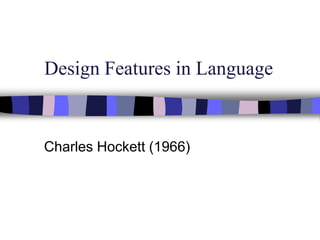
Hockett
- 1. Design Features in Language Charles Hockett (1966)
- 2. Charles Hockett "The design-features listed below are found in every language on which we have reliable information, and each seems to be lacking in at least one known animal communicative system. They are not all logically independent, and do not necessarily all belong to our defining list for language--a point to be taken up separately..."
- 3. Channel Mode of communication-vocal-auditory, tacticle-visual, or chemical-olfactory Humans use vocal-auditory, but so do frogs and coyotes.
- 4. Temporality Rapid Fading: Message does not linger in time or space after production. Sounds and signs are guaranteed to fade rapidly. Chemicals hang around.
- 5. Interchangeability Individuals who use a language can both send and receive any permissible message within that communication system. Coyotes can either howl or listen to howls.
- 6. Feedback Users of a language can perceive what they are transmitting and can make corrections if they make errors. Apes can hear themselves call. Bees don’t see their own dances.
- 7. Specialization The direct-energetic consequences of linguistic signals are usually biologically trivial; only the triggering effects. Speech does little in terms of helping us eat. Its only use is for talking.
- 8. Semanticity There are associative ties between signal elements and features in the world; in short, some linguistic forms have denotations. Our words actually refer to things, not just emotions or states.
- 9. Arbitrariness There is no logical connection between the form of the signal and its meaning. The words “tree,” “baum,” “arbol” all refer to the object: The words are all signifiers, while the object is the signified. Together, they make the sign.
- 10. Discreteness Messages in the system are made up of smaller, repeatable parts; the sounds of language (or cheremes of a sign) are perceived categorically, not continuously. /k/ + /ae/ + /t/ = “cat” /t/ + /ae/ + /k/ = “tack”
- 11. Displacement Linguistic messages may refer to things remote in time and space, or both, from the site of the communication. Talk about what has happened, what will happen, what didn’t happen, etc.
- 12. Productivity Users can create and understand completely novel messages. 10.1. In a language, new messages are freely coined by blending, analogizing from, or transforming old ones. This says that every language has grammatical patterning. 10.2. In a language, either new or old elements are freely assigned new semantic loads by circumstances and context. This says that in every language new idioms constantly come into existence.
- 13. Productivity Language makes infinite use of finite means. At every level of the analysis of language (phonology, morphology, and syntax), we find: a finite set of elements (phonemes, morphemes, grammatical classes) combined through a finite set of rules (phonological rules, morphological rules, syntactic rules) to generate an infinite number of possibilities.
- 14. Cultural transmission The conventions of a language are learned by interacting with more experienced users. Dialect differences among birdsong.
- 15. Duality (of Patterning) A large number of meaningful elements are made up of a conveniently small number of meaningless but message-differentiating elements.
- 16. Prevarication Linguistic messages can be false, deceptive, or meaningless.
- 17. Reflexiveness In a language, one can communicate about communication.
- 18. Learnability A speaker of a language can learn another language.
- 19. Charles Hockett "There is...a sense in which [productivity], displacement, and duality...can be regarded as the crucial, or nuclear, or central properties of human language."
- 20. Bee dancing Channel tactile/visual/chemical Temporality extended Interchangeability limited Feedback ? Specialization ? Semanticity yes Arbitrariness no Discreetness maybe Displacement sure Productivity no Cultural Transmission no Duality of Patterning no Prevarication no Reflexiveness no Learnability no
- 21. Vervet monkeys Channel vocal-auditory Temporality transient (but repeated) Interchangeability yes Feedback yes Specialization yes Semanticity yes Arbitrariness yes Discreetness yes Displacement no Productivity no Cultural Transmission no Duality of Patterning no Prevarication no Reflexiveness no Learnability no
- 22. Washoe (and other apes) Channel visual Temporality transient (but often perseverative) Interchangeability yes Feedback yes Specialization yes Semanticity yes Arbitrariness yes Discreetness yes Displacement yes Productivity some Cultural Transmission no Duality of Patterning ? Prevarication yes Reflexiveness no Learnability yes
- 23. Alex the parrot Channel vocal-auditory Temporality transient Interchangeability yes Feedback yes Specialization yes Semanticity yes Arbitrariness yes Discreetness yes Displacement no Productivity no Cultural Transmission no Duality of Patterning no Prevarication yes Reflexiveness no Learnability yes
- 24. Humpback whales Channel auditory Temporality transient (but often perseverative) Interchangeability yes Feedback yes Specialization yes Semanticity yes Arbitrariness ? Discreetness ? Displacement ? Productivity no Cultural Transmission maybe Duality of Patterning ? Prevarication ? Reflexiveness no Learnability probably not
